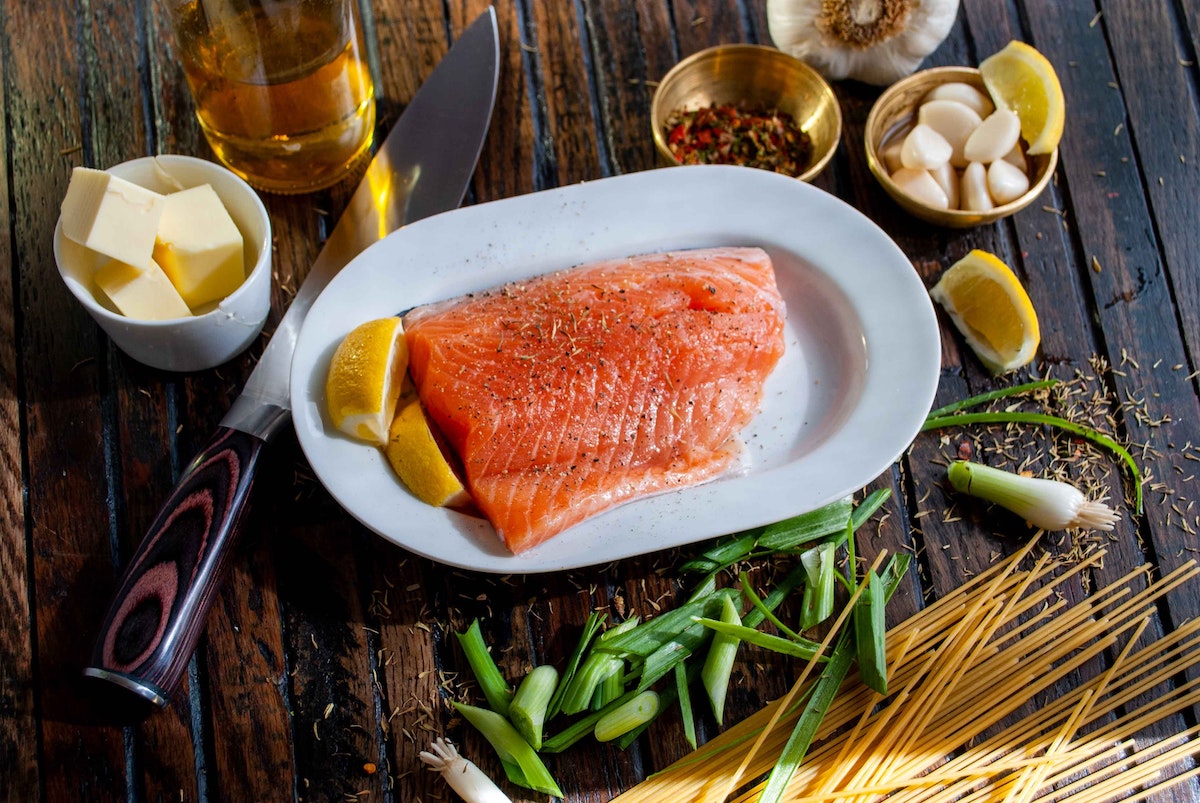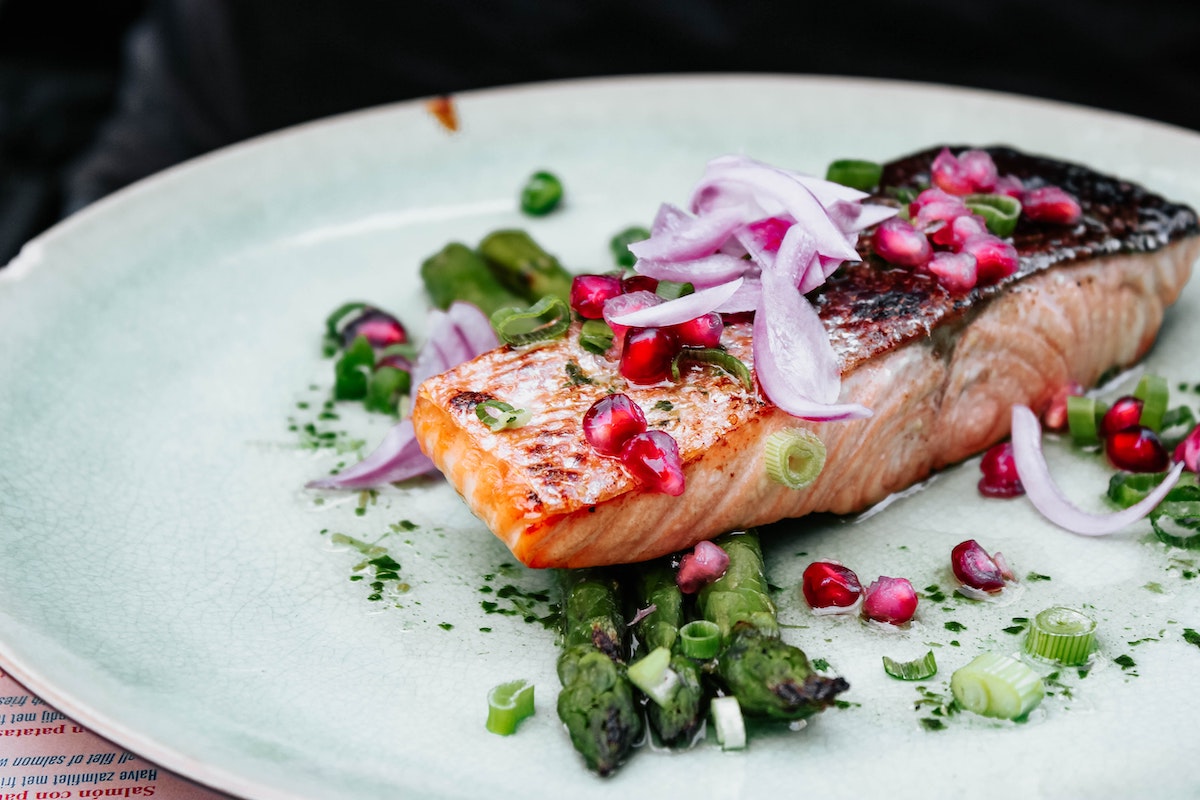What does salmon taste like? Salmon tastes delicate with a rich flavor, and slightly oily profile. Grilled, baked, or poached salmon often exhibits buttery and citrus notes, complementing the accompanying dish. Smoked salmon has a distinct smoky, mildly fishy taste, while canned salmon may taste bland or oily.
If you’ve never had salmon, you might be interested in what makes it special, like how it tastes, how it’s used, and how it feels.
Adding fish to your diet is good for you in many ways, and salmon is one of the easiest and healthiest choices.
Salmon is a tasty fish that can be enjoyed in a wide range of cuisines because it can be cooked in a number of different ways. Its versatility makes it one of the most sought-after fish varieties.
Raw salmon is a popular ingredient in dishes like sushi and ceviche Its versatile flavor pairs well with rice, greens, citrus and more But for those who have never tried raw salmon, the taste can be hard to describe. Is it fishy? Metallic? Sweet? Get ready to become a raw salmon connoisseur with this complete guide to the flavors.
An Overview of Raw Salmon’s Taste
Raw salmon has a mild, sweet and buttery taste. When very fresh, the flavor is clean, pure and delicate. There is a subtle brininess similar to raw shellfish like oysters or clams. The umamiflavor comes across as more savory than fishy.
High quality sashimi or sushi-grade salmon has a silky, velvety texture. The soft fat almost seems to melt on your tongue as you chew. The mouthfeel is rich and soothing. There isn’t any metallic fishiness or barnyard muddiness that you usually get with cheaper seafood.
Truly fresh raw salmon is pleasantly sweet upfront, followed by an elegant butteriness. The finish is a light lingering brine. The overall profile is well-balanced and highly versatile for pairing with other ingredients.
Factors That Influence Raw Salmon’s Taste
Many variables affect the final flavor of raw salmon Here are some of the key factors
-
Freshness – Fresher salmon has a cleaner, purer taste. Aging introduces muddy and fishy undertones.
-
Content of fat: King and Sockeye salmon taste fuller than Pink and Coho salmon, which are leaner.
-
Wild vs Farmed – Wild salmon develop a more complex flavor profile from their natural diet. Farmed salmon tastes milder.
-
Preparation – Sushi-grade salmon is bled, cleaned and flash-frozen to optimize taste.
-
Cooking Method – Seared or smoked salmon takes on caramelized and woody flavors.
-
Curing – Salt, sugar and spices in cured salmon enhance savoriness.
-
Species – Different salmon types have varying levels of fattiness, shelflife and flavor.
-
Water Source – Salmon from cleaner waters tend to taste sweeter and purer.
Understanding these variables helps explain the range of possible flavors you may experience when tasting different types of raw salmon.
Descriptions of Raw Salmon’s Taste By Species
One of the biggest determinants of salmon’s flavor is the species. Here is how the taste of raw salmon differs across some common varieties:
Pink Salmon
- Lean and low in fat
- Delicate texture
- Mild, subtle flavor
- Notes of melon and cucumber
Sockeye Salmon
- Rich, fatty flesh
- Smooth, sumptuous texture
- Robust flavor
- Sweet and buttery taste
Coho Salmon
- Medium fat content
- Velvety texture
- Bright, delicate flavor
- Notes of citrus
King Salmon
- Very high in fat
- Silky, opulent texture
- Intense, rich flavor
- Almost nutty or eggy taste
Atlantic Salmon
- Lower fat than Pacific species
- Firm texture
- Mild, neutral flavor
- Less sweetness and butteriness
So a fattier King salmon will provide a very different experience than a lean Pink when eaten raw. Tasting different types of sashimi or sushi is the best way to appreciate their unique textures and flavors.
How Preparation Affects Raw Salmon’s Taste
Eating salmon raw from the flesh of the fish is vastly different than cured, smoked or cooked preparations. Here’s how preparation affects the salmon tasting experience:
-
Sashimi – Thin slices of the freshest raw salmon. Sweet, tender and mellow.
-
Carpaccio – Thinly sliced raw salmon, sometimes marinated in oil or citrus. More intense flavor.
-
Poke – Cubed raw salmon tossed with sauces and spices. Flavorings adhere to the fish.
-
Ceviche – “Cooked” in citric acid. Acidic and tangy tasting.
-
Gravlax – Cured in salt, sugar and dill. Strong umami and herbal notes.
-
Smoked Salmon – Cold smoked retains raw texture. Warm smoked flakes apart. Wood smoke flavor.
-
Seared Salmon – Searing gives a caramelized, savory taste.
-
Poached Salmon – Gentle poaching keeps salmon tender and moist. Pure, delicate flavor.
So the same high quality salmon can provide very unique experiences based on how it’s prepared. Personally tasting all the variations is the best way to discover your favorites!
Does Quality and Freshness Affect the Taste?
Absolutely! Low quality salmon tends to taste fishy, metallic and muddy. Signs of poor freshness include:
- Ammonia smell
- Slimy texture
- Discoloration
- Dull, dry appearance
In contrast, fresh sushi-grade salmon has a clean sea breeze aroma, glistening sheen, and firms moist texture. The fresher the salmon, the milder and sweeter the natural flavor will be.
Sushi restaurants serve the highest quality cuts of salmon for preparing nigiri, sashimi and rolls. This ensures an optimal taste and texture when eaten raw.
The highest standard comes from salmon that is:
- Wild-caught
- Immediately iced
- Skillfully filleted
- Promptly sushi-graded
- Flash frozen
- Thawed to order
Such pristine handling eliminates contaminants and locks in freshness. The result is a buttery sweetness without any acrid or fishy undertones. A cut above standard grocery salmon.
Tips for Purchasing Raw Salmon for Optimal Flavor
Seeking the best tasting raw salmon? Here are some buying tips for maximizing flavor:
-
Look for chill-killed sushi-grade cuts at specialty seafood markets or Asian groceries. This salmon was handled for raw consumption.
-
Seek out wild-caught varieties like Sockeye and Coho for more complexity.
-
Find responsibly farmed salmon if wild is not available. Well-managed farms produce tender, mild fish.
-
Pick thick, center-cut fillets that look moist and firm. Avoid thin tail-end pieces.
-
Select salmon with clear eyes, vibrant red flesh and no dull or browning spots.
-
Give salmon a sniff test. It should smell pleasantly like the ocean, not fishy or sour.
-
Ask questions about sourcing and processing methods if buying directly from a fishmonger.
-
Be willing to spend a little more for quality that ensures the best possible flavor.
Simple Serving Suggestions to Let the Salmon Shine
Raw salmon has a delicate flavor profile easily lost behind heavy sauces or seasoning. To let the natural tastes shine, stick to light enhancements like:
- Fresh lemon or lime juice
- Fine sea salt
- Fresh grated ginger or wasabi
- Soy sauce or tamari
- Rice vinegar
- Sesame oil
- Nori strips
- Chives
- Shaved radish or fennel
- Tobiko caviar
Simple combinations like salmon sashimi garnished with sliced green onion and ponzu sauce allow the glorious fresh fish to take center stage.
Important Safety Tips for Consuming Raw Seafood
It’s crucial to follow proper handling when eating raw salmon. To avoid any foodborne illness:
-
Seek out reputable sushi restaurants and fish markets. Poor quality control raises risks.
-
Ensure raw salmon was previously frozen to required temperatures to kill parasites. Such fish should be labeled sushi-grade or sashimi-grade.
-
Inspect the salmon first and do not consume if it has an off smell or appearance.
-
Consume raw salmon within 2 days of thawing for best quality and safety.
-
Avoid raw salmon if you have certain medical conditions like liver disease or suppressed immunity.
The Takeaway on Raw Salmon’s Taste
Hopefully this guide has shed light on the subtle beauty of raw salmon’s flavor. When optimally fresh, the taste can be clean, velvety, sweet and sublime. Raw salmon finds balance with bright acidic complements like citrus and soy. For the fullest experience, taste across the spectrum of salmon species and preparations. With some knowledge of the flavors and safety precautions, raw salmon can become a delicious addition to your diet.

What’s The Texture of Salmon Like?
The texture of salmon can vary greatly depending on its preparation and cooking techniques. To better understand these differences, we’ve categorized the fish by the various ways it can be cooked.

Raw salmon boasts a smooth, thick, and dense texture with some elasticity. It’s easy to cut, but if it looks sticky or stringy, it might be bad and should be thrown away.
Why Does Salmon Taste So Good?
Salmon, with its striking bright orange-pink hue, is a favorite among seafood lovers across the globe. This type of fish can live in both saltwater and freshwater, but it mostly lives in the Pacific Ocean and some North Atlantic rivers that flow into it.

The quality of salmon depends on its origin, with wild-caught salmon generally being healthier than farmed varieties. Its meat is less flaky than that of other fish, like halibut or sea bass, which makes it a good choice for many dishes.
Salmon’s popularity in a wide range of cuisines comes from the fact that it goes well with a lot of different flavors. This versatile fish is used in a huge number of dishes around the world, making it a must-have for many foodies.
What Types Of Fresh and Frozen Salmon Can You Eat Raw? Walmart? Whole Foods?
FAQ
Is it okay to eat salmon raw?
Why is raw salmon delicious?
Should salmon sushi taste fishy?
What tastes better raw or cooked salmon?
What does raw salmon taste like?
Raw salmon tastes like it’s melting on your tongue, and the typical flavors of the fish will depend on where the salmon had thrived. If you’re dealing with raw wild salmon, then you’ll experience rich and wonderful flavors exploding upon your tongue. Whereas farmed salmon packs a milder flavor.
What are the benefits of smoked salmon over raw salmon?
It actually has the same characteristics as raw salmon, being relatively low in calories, it is an excellent source of protein, good fat and several vitamins and minerals. The smoking process just adds an aroma.
How do you know if salmon is cooked or raw?
For instance, you will have to pay close attention to the color of the salmon and the smell. Thus, when salmon is cooked it usually gets some kind of a light pinkish color, while the raw salmon is red. In other words, when salmon is raw, it has some kind of translucent color, and when cooked, this color changes into an opaque one.
What does raw salmon look like?
However, there are small details that can help you with the question, of what does raw salmon look like. For instance, you will have to pay close attention to the color of the salmon and the smell. Thus, when salmon is cooked it usually gets some kind of a light pinkish color, while the raw salmon is red.
Can raw salmon taste bad?
Raw salmon also plays the main role in cold salads with dill and mustard. In these kinds of combinations, raw salmon can’t taste bad. In other words, raw salmon is usually eaten in combination with something else, or as an appetizer. It is not common for people to eat raw salmon as their main dish.
What does canned salmon taste like?
Canned salmon usually has an oily and bland taste, but people mostly buy it for convenience because it’s already cooked. Some high-quality canned salmon have a fatty and vibrant flavor, but most lack fresh salmon’s tender and smooth texture. Poached, baked, or grilled salmon tastes buttery and citrusy.
